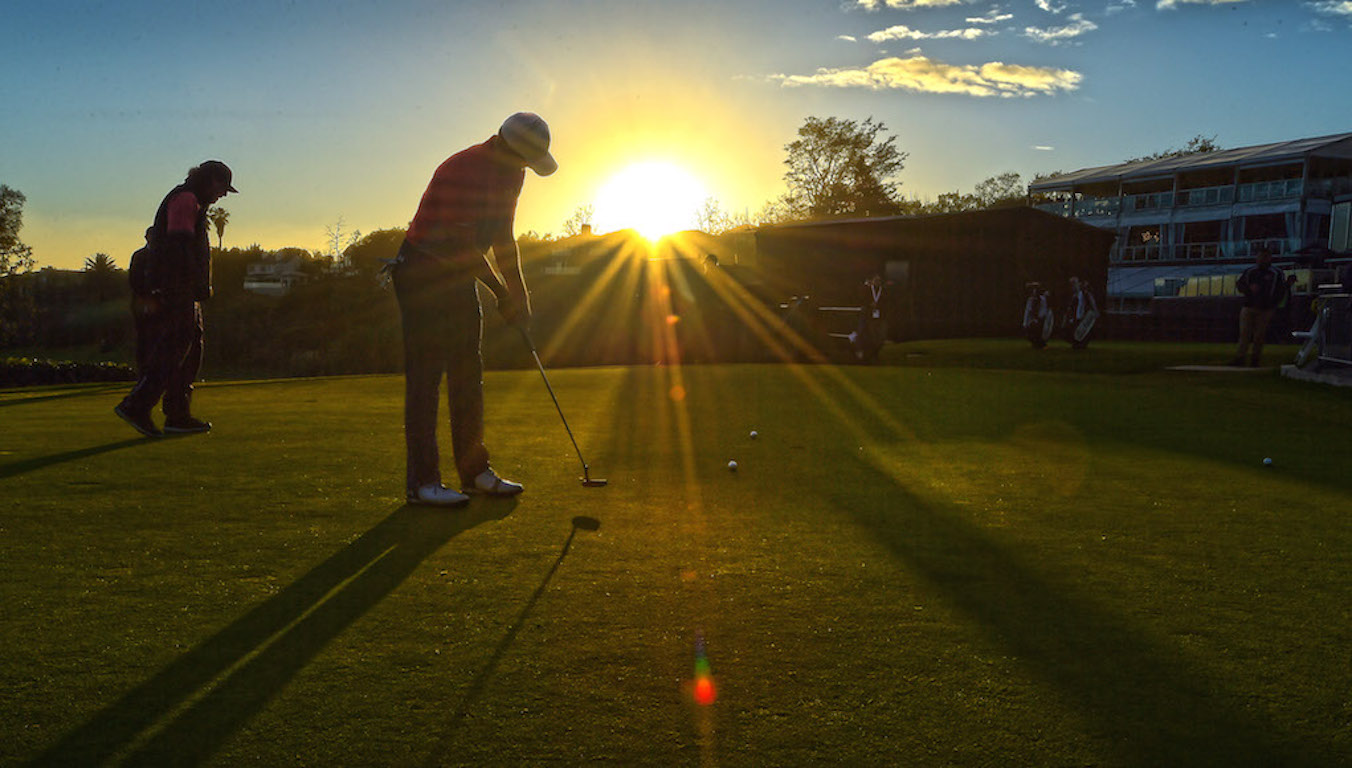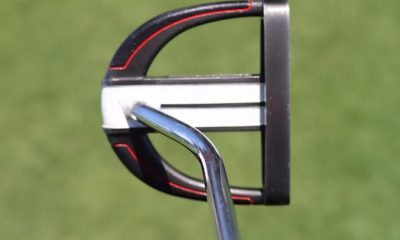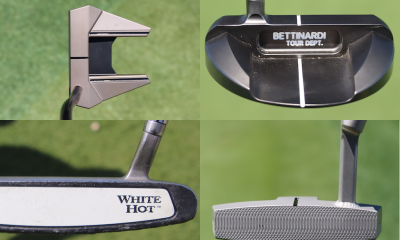Opinion & Analysis
The Wedge Guy: A putting experiment

One of the most fun and challenging things about this great game we all play is that there are myriad things to explore and try, keeping those that work for you and discarding those that don’t. While I realize many golfers just go out and play without giving it much thought, my bet is that most all of you who follow GolfWRX, and particularly weekly columns like mine, are always looking for ways to improve. I’m no different. In fact, I probably illustrate the extreme of experimentation because I’ve spent a lifetime in the game and over 40 years in the golf equipment industry.
In follow-up to last week’s post about the “Two putting triangles,” I thought I would share a recent experiment I’ve been conducting on my own putting. If this just gives any of you an idea that can shave a stroke or two, then I’ve earned my keep, so to speak.
I had been struggling on the greens a bit, not getting nearly as much out of my rounds as I thought I should. And one of the main culprits was that I was just not converting enough of my makeable putts. While my lag putting has been very good, leaving me very short second putts most of the time, where I thought I was sub-standard for an experienced low handicap player was in my success rate in making those “money putts” from 8-15 feet, and I felt like I missed more than my fair share of putts from three to eight feet in length.
To be honest, I tend to get a little “yippy” on those short putts sometimes, but it seemed that mostly my failure to make those putts drilled down to the face angle at impact. I might pull one and push the next one, so I decided to try something new a few rounds ago.
You all know I’m quite the follower and analyst of PGA Tour statistics as a benchmark for performance, so I started there to establish my goals. Here’s what I found.
The PGA Tour average from 4 to 8 feet is just under 69 percent. Given that these guys are the best in the world, have perfect greens every week and experienced caddies to give them a second set of eyes (which have also studied the greens extensively), I figured if I could attain a 50 percent sink rate from that range, I would be “golden”.
Moving out to the range of 10-15 feet, the PGA Tour average drops significantly, to just under 30 percent — only three out of every 10 tries from this range do the tour players make their putts. So, I figured given my recreational status, grainy greens and some very puzzling breaks on my golf course, my personal goal from 10 to 15 feet should be somewhere between one to two putts out of every 10.
In an effort to achieve this improved performance on those shorter putts, I began to experiment on my putting track at home with a “left hand low” grip on the putter. I’ve always gravitated to blade style putters, and usually have one of my own design in the bag. Many years ago, I became convinced that a face-balanced design improve my odds of keeping the face square through impact. But a couple of months before this experiment began, I received a putter from an industry friend that exhibited what is called “lie angle balanced,” the premise being that the face angle is essentially “built in” to the path of the putting stroke.
Anyway, I began to practice making putts of 7-9 feet on my putting track at home and explored its effect with a number of different putters that lean against the wall in my office — all while working to determine the right “left hand low” grip for me. What I found was that it was really easy to get in a groove on the putting track, so it was time to take this to the course.
I quickly found that my putting from these crucial distances visibly improved immediately with the left-hand-low grip. I reduced the action to a simple back and through, and both my “yippi-ness” and face control were dramatically impacted.
So, then I began to keep some stats of my own and here’s what happened over the course of the next 10-12 rounds.
My make percentage on putts under eight feet has improved to almost 60 percent, not that far below the PGA Tour average. Wow. And on putts of 8 to 15 feet, my make percentage leaped to 22 percent, even closer to the tour average. As you can imagine, my golf buddies noticed the change and my scoring dropped by as much as 3-4 shots per round.
Where I’m keeping it different is that I putt the longer putts with my comfortable conventional grip, as it engages the fingertips of my master right hand for optimized touch and feel. So, when success is more about speed than line, I go conventional. But inside 15 feet or so, I employ the left-hand-low grip as those putts are more about line than speed.
While I have always been quite the traditionalist in my approach to this game, I like making putts and shooting lower scores as much as any of you. If you are not converting shorter putts as often as you think you should, you might give this two-grip approach a try.
- LIKE62
- LEGIT7
- WOW0
- LOL1
- IDHT0
- FLOP1
- OB0
- SHANK3
19th Hole
Vincenzi’s 2024 Zurich Classic of New Orleans betting preview

The PGA TOUR heads to New Orleans to play the 2023 Zurich Classic of New Orleans. In a welcome change from the usual stroke play, the Zurich Classic is a team event. On Thursday and Saturday, the teams play best ball, and on Friday and Sunday the teams play alternate shot.
TPC Louisiana is a par 72 that measures 7,425 yards. The course features some short par 4s and plenty of water and bunkers, which makes for a lot of exciting risk/reward scenarios for competitors. Pete Dye designed the course in 2004 specifically for the Zurich Classic, although the event didn’t make its debut until 2007 because of Hurricane Katrina.
Coming off of the Masters and a signature event in consecutive weeks, the field this week is a step down, and understandably so. Many of the world’s top players will be using this time to rest after a busy stretch.
However, there are some interesting teams this season with some stars making surprise appearances in the team event. Some notable teams include Patrick Cantlay and Xander Schauffele, Rory McIlroy and Shane Lowry, Collin Morikawa and Kurt Kitayama, Will Zalatoris and Sahith Theegala as well as a few Canadian teams, Nick Taylor and Adam Hadwin and Taylor Pendrith and Corey Conners.
Past Winners at TPC Louisiana
- 2023: Riley/Hardy (-30)
- 2022: Cantlay/Schauffele (-29)
- 2021: Leishman/Smith (-20)
- 2019: Palmer/Rahm (-26)
- 2018: Horschel/Piercy (-22)
- 2017: Blixt/Smith (-27)
2024 Zurich Classic of New Orleans Picks
Tom Hoge/Maverick McNealy +2500 (DraftKings)
Tom Hoge is coming off of a solid T18 finish at the RBC Heritage and finished T13 at last year’s Zurich Classic alongside Harris English.
This season, Hoge is having one of his best years on Tour in terms of Strokes Gained: Approach. In his last 24 rounds, the only player to top him on the category is Scottie Scheffler. Hoge has been solid on Pete Dye designs, ranking 28th in the field over his past 36 rounds.
McNealy is also having a solid season. He’s finished T6 at the Waste Management Phoenix Open and T9 at the PLAYERS Championship. He recently started working with world renowned swing coach, Butch Harmon, and its seemingly paid dividends in 2024.
Keith Mitchell/Joel Dahmen +4000 (DraftKings)
Keith Mitchell is having a fantastic season, finishing in the top-20 of five of his past seven starts on Tour. Most recently, Mitchell finished T14 at the Valero Texas Open and gained a whopping 6.0 strokes off the tee. He finished 6th at last year’s Zurich Classic.
Joel Dahmen is having a resurgent year and has been dialed in with his irons. He also has a T11 finish at the PLAYERS Championship at TPC Sawgrass which is another Pete Dye track. With Mitchell’s length and Dahmen’s ability to put it close with his short irons, the Mitchell/Dahmen combination will be dangerous this week.
Taylor Moore/Matt NeSmith +6500 (DraftKings)
Taylor Moore has quickly developed into one of the more consistent players on Tour. He’s finished in the top-20 in three of his past four starts, including a very impressive showing at The Masters, finishing T20. He’s also finished T4 at this event in consecutive seasons alongside Matt NeSmith.
NeSmith isn’t having a great 2024, but has seemed to elevate his game in this format. He finished T26 at Pete Dye’s TPC Sawgrass, which gives the 30-year-old something to build off of. NeSmith is also a great putter on Bermudagrass, which could help elevate Moore’s ball striking prowess.
- LIKE8
- LEGIT3
- WOW1
- LOL1
- IDHT0
- FLOP3
- OB1
- SHANK2
19th Hole
Vincenzi’s 2024 LIV Adelaide betting preview: Cam Smith ready for big week down under

After having four of the top twelve players on the leaderboard at The Masters, LIV Golf is set for their fifth event of the season: LIV Adelaide.
For both LIV fans and golf fans in Australia, LIV Adelaide is one of the most anticipated events of the year. With 35,000 people expected to attend each day of the tournament, the Grange Golf Club will be crawling with fans who are passionate about the sport of golf. The 12th hole, better known as “the watering hole”, is sure to have the rowdiest of the fans cheering after a long day of drinking some Leishman Lager.
The Grange Golf Club is a par-72 that measures 6,946 yards. The course features minimal resistance, as golfers went extremely low last season. In 2023, Talor Gooch shot consecutive rounds of 62 on Thursday and Friday, giving himself a gigantic cushion heading into championship Sunday. Things got tight for a while, but in the end, the Oklahoma State product was able to hold off The Crushers’ Anirban Lahiri for a three-shot victory.
The Four Aces won the team competition with the Range Goats finishing second.
*All Images Courtesy of LIV Golf*
Past Winners at LIV Adelaide
- 2023: Talor Gooch (-19)
Stat Leaders Through LIV Miami
Green in Regulation
- Richard Bland
- Jon Rahm
- Paul Casey
Fairways Hit
- Abraham Ancer
- Graeme McDowell
- Henrik Stenson
Driving Distance
- Bryson DeChambeau
- Joaquin Niemann
- Dean Burmester
Putting
- Cameron Smith
- Louis Oosthuizen
- Matt Jones
2024 LIV Adelaide Picks
Cameron Smith +1400 (DraftKings)
When I pulled up the odds for LIV Adelaide, I was more than a little surprised to see multiple golfers listed ahead of Cameron Smith on the betting board. A few starts ago, Cam finished runner-up at LIV Hong Kong, which is a golf course that absolutely suits his eye. Augusta National in another course that Smith could roll out of bed and finish in the top-ten at, and he did so two weeks ago at The Masters, finishing T6.
At Augusta, he gained strokes on the field on approach, off the tee (slightly), and of course, around the green and putting. Smith able to get in the mix at a major championship despite coming into the week feeling under the weather tells me that his game is once again rounding into form.
The Grange Golf Club is another course that undoubtedly suits the Australian. Smith is obviously incredibly comfortable playing in front of the Aussie faithful and has won three Australian PGA Championship’s. The course is very short and will allow Smith to play conservative off the tee, mitigating his most glaring weakness. With birdies available all over the golf course, there’s a chance the event turns into a putting contest, and there’s no one on the planet I’d rather have in one of those than Cam Smith.

Louis Oosthuizen +2200 (DraftKings)
Louis Oosthuizen has simply been one of the best players on LIV in the 2024 seas0n. The South African has finished in the top-10 on the LIV leaderboard in three of his five starts, with his best coming in Jeddah, where he finished T2. Perhaps more impressively, Oosthuizen finished T7 at LIV Miami, which took place at Doral’s “Blue Monster”, an absolutely massive golf course. Given that Louis is on the shorter side in terms of distance off the tee, his ability to play well in Miami shows how dialed he is with the irons this season.
In addition to the LIV finishes, Oosthuizen won back-to-back starts on the DP World Tour in December at the Alfred Dunhill Championship and the Mauritus Open. He also finished runner-up at the end of February in the International Series Oman. The 41-year-old has been one of the most consistent performers of 2024, regardless of tour.
For the season, Louis ranks 4th on LIV in birdies made, T9 in fairways hit and first in putting. He ranks 32nd in driving distance, but that won’t be an issue at this short course. Last season, he finished T11 at the event, but was in decent position going into the final round but fell back after shooting 70 while the rest of the field went low. This season, Oosthuizen comes into the event in peak form, and the course should be a perfect fit for his smooth swing and hot putter this week.

- LIKE12
- LEGIT3
- WOW1
- LOL1
- IDHT0
- FLOP1
- OB1
- SHANK1
Opinion & Analysis
The Wedge Guy: What really makes a wedge work? Part 1

Of all the clubs in our bags, wedges are almost always the simplest in construction and, therefore, the easiest to analyze what might make one work differently from another if you know what to look for.
Wedges are a lot less mysterious than drivers, of course, as the major brands are working with a lot of “pixie dust” inside these modern marvels. That’s carrying over more to irons now, with so many new models featuring internal multi-material technologies, and almost all of them having a “badge” or insert in the back to allow more complex graphics while hiding the actual distribution of mass.
But when it comes to wedges, most on the market today are still single pieces of molded steel, either cast or forged into that shape. So, if you look closely at where the mass is distributed, it’s pretty clear how that wedge is going to perform.
To start, because of their wider soles, the majority of the mass of almost any wedge is along the bottom third of the clubhead. So, the best wedge shots are always those hit between the 2nd and 5th grooves so that more mass is directly behind that impact. Elite tour professionals practice incessantly to learn to do that consistently, wearing out a spot about the size of a penny right there. If impact moves higher than that, the face is dramatically thinner, so smash factor is compromised significantly, which reduces the overall distance the ball will fly.
Every one of us, tour players included, knows that maddening shot that we feel a bit high on the face and it doesn’t go anywhere, it’s not your fault.
If your wedges show a wear pattern the size of a silver dollar, and centered above the 3rd or 4th groove, you are not getting anywhere near the same performance from shot to shot. Robot testing proves impact even two to three grooves higher in the face can cause distance loss of up to 35 to 55 feet with modern ‘tour design’ wedges.
In addition, as impact moves above the center of mass, the golf club principle of gear effect causes the ball to fly higher with less spin. Think of modern drivers for a minute. The “holy grail” of driving is high launch and low spin, and the driver engineers are pulling out all stops to get the mass as low in the clubhead as possible to optimize this combination.
Where is all the mass in your wedges? Low. So, disregarding the higher lofts, wedges “want” to launch the ball high with low spin – exactly the opposite of what good wedge play requires penetrating ball flight with high spin.
While almost all major brand wedges have begun putting a tiny bit more thickness in the top portion of the clubhead, conventional and modern ‘tour design’ wedges perform pretty much like they always have. Elite players learn to hit those crisp, spinny penetrating wedge shots by spending lots of practice time learning to consistently make contact low in the face.
So, what about grooves and face texture?
Grooves on any club can only do so much, and no one has any material advantage here. The USGA tightly defines what we manufacturers can do with grooves and face texture, and modern manufacturing techniques allow all of us to push those limits ever closer. And we all do. End of story.
Then there’s the topic of bounce and grinds, the most complex and confusing part of the wedge formula. Many top brands offer a complex array of sole configurations, all of them admittedly specialized to a particular kind of lie or turf conditions, and/or a particular divot pattern.
But if you don’t play the same turf all the time, and make the same size divot on every swing, how would you ever figure this out?
The only way is to take any wedge you are considering and play it a few rounds, hitting all the shots you face and observing the results. There’s simply no other way.
So, hopefully this will inspire a lively conversation in our comments section, and I’ll chime in to answer any questions you might have.
And next week, I’ll dive into the rest of the wedge formula. Yes, shafts, grips and specifications are essential, too.
- LIKE34
- LEGIT7
- WOW1
- LOL1
- IDHT2
- FLOP3
- OB1
- SHANK3
-

 19th Hole2 weeks ago
19th Hole2 weeks agoDave Portnoy places monstrous outright bet for the 2024 Masters
-

 19th Hole4 days ago
19th Hole4 days agoJustin Thomas on the equipment choice of Scottie Scheffler that he thinks is ‘weird’
-

 19th Hole2 weeks ago
19th Hole2 weeks agoTiger Woods arrives at 2024 Masters equipped with a putter that may surprise you
-

 19th Hole4 days ago
19th Hole4 days ago‘Absolutely crazy’ – Major champ lays into Patrick Cantlay over his decision on final hole of RBC Heritage
-

 19th Hole2 weeks ago
19th Hole2 weeks agoTwo star names reportedly blanked Jon Rahm all week at the Masters
-

 19th Hole1 week ago
19th Hole1 week agoReport: LIV Golf identifies latest star name they hope to sign to breakaway tour
-

 19th Hole2 weeks ago
19th Hole2 weeks agoNeal Shipley presser ends in awkward fashion after reporter claims Tiger handed him note on 8th fairway
-

 19th Hole1 week ago
19th Hole1 week agoBrandel Chamblee has ‘no doubt’ who started the McIlroy/LIV rumor and why
























Garrett
Aug 6, 2022 at 11:01 am
I have said this is in the forums ad nauseum, but every putter that is not a fitted LAB putter is physically fighting you, and I recommend you not play it. I have literally shaved 5+ strokes a round on the greens since I switched to a LAB broomstick 2 years ago. Putting is now the most enjoyable part of the game and my confidence is through the roof. I can not stress enough how good these things are.
Jax
Aug 4, 2022 at 3:38 am
The true missed point is lie angle. Faced balanced lie angle is very nice (if you can stand the looks of the LAB putters), but actually just getting a putter bent to the right lie angle is SUPER IMPORTANT and almost always overlooked.
SV677
Aug 3, 2022 at 4:40 pm
Congratulations, you have come to the same conclusion as Lydia Ko. While watching the women this weekend the announcers mentioned she was doing the same. I tried it. It didn’t work for me, but it was worth trying. I may stay with it for a while to see if there is any improvement.
Steve Hjortness
Aug 3, 2022 at 11:15 am
Terry, your story is one I can relate to, but I have yet to find a solution. In your discussion, you stated you made two changes: a left hand low grip and a LAB putter. That kind of makes it tough to determine which change led to the improvement. Do you believe one or the other was the main contributor to your success or the combination of both?
Terry Koehler
Sep 8, 2022 at 11:55 am
Steve,
I think the LAB putter was definitely a significant part of the equation, but the left hand low approach was instrumental in addressing my tendency to get a bit “yippy” on those shorter putts. Together, its been a super-effective combination for me.
Greg
Aug 3, 2022 at 10:54 am
Combined with your last article on the counterrotation that must be applied to square the putter face and your mention of the “lie angle balanced” putter in this one. Is this a bigger part of the equation than is being alluded to? Does this lie angle balancing reduce the amount of counterrotation that needs to be applied to square the face thereby making that squaring more repeatable?
Meet Terry Koehler
Sep 8, 2022 at 11:53 am
Yes, Greg. Having designed over 100 putters, from conventional to face-balanced, I find the LAB lie angle balancing to the “the real deal”. Controlling face angle is the single hardest part of putting in my opinion, and this practically eliminates that from the equation.